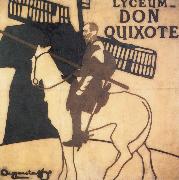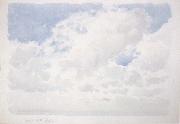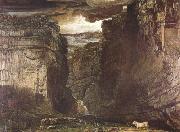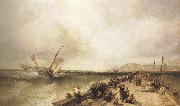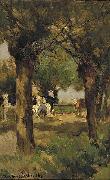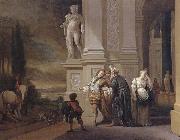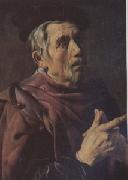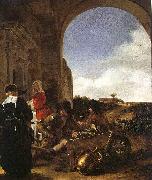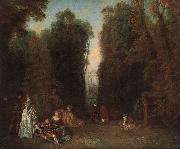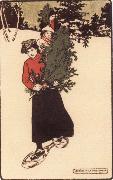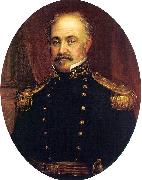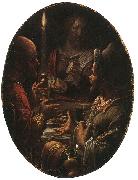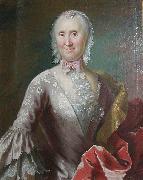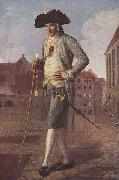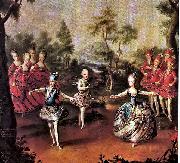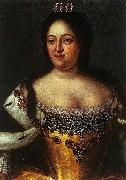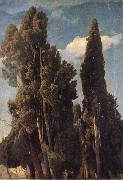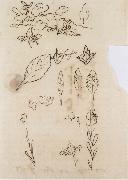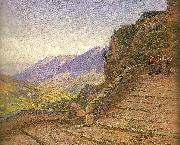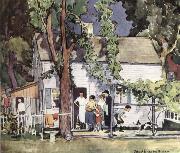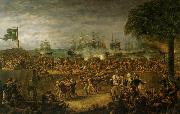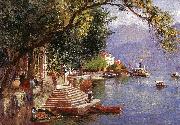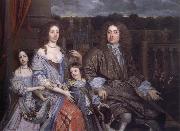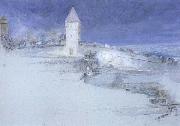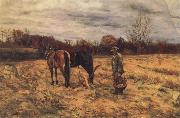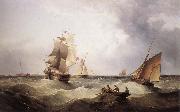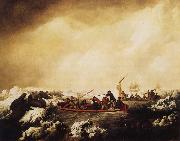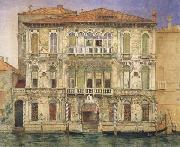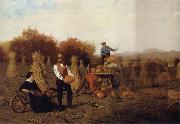|
|
|
|
|
|
|
|
|
|
|
|
 |
James Wilson Morrice
|
|
(August 10, 1865 Montreal - January 23, 1924 Tunis) was a significant Canadian landscape painter. He studied at the Academie Julian in Paris, France, where he lived for most of his career.
Morrice was the son of a wealthy merchant, and studied law in Toronto from 1882 to 1889. In 1890 he left to study painting in England. The next year he arrived in Paris, where he studied at the Academie Julian from 1892-7. At Julians he befriended Charles Conder and Maurice Prendergast, and also met Robert Henri.
Morrice continued to live in Paris until the First World War, although he spent most of his winters in Canada. He made many connections in the intellectual circles of Paris, while also remaining in touch with the Canadian art world:
|
|
 |
Jan Baptist Weenix
|
|
(Amsterdam, 1621- Vleuten 1660), a painter of the Dutch Golden Age. Despite his relatively brief career, he was a very productive and versatile painter. His favourite subjects were Italian landscapes with large figures among ruins, seaside views, and, later in life, large still life pictures of dead game or dogs. He was mainly responsible for introducing the Italian harbour scene into Dutch art, in mid-size paintings with a group of figures in the foreground.
Weenix was the son of an architect and born near Amsterdam's harbour. He could not speak well, apparently from a medical condition, and because he very much liked to read books, his mother sent him to work for a bookseller, who was not able to deal with him. He drew whenever he could, according to Jan Weenix his son, who told the story to Arnold Houbraken.
Weenix first studied under Jan Micker, then in Utrecht under Abraham Bloemaert, and later back in Amsterdam under Claes Cornelisz. Moeyaert. In 1643 Weenix travelled to Rome with Nicolaes Pieterszoon Berchem. He had left his home secretly, but his wife, the daughter of Gillis d'Hondecoeter, traced him to Rotterdam. Then he was allowed to stay away for four months. In Rome he became a member of the Bentvueghels and was much esteemed and worked for Pope Innocent X. He returned to Amsterdam after four years; his wife had refused to come to Rome.
In 1649 he became master of the guild of St. Luke in Utrecht and also painted a portrait of Rene Descartes. When his brother-in-law Gijsbert d'Hondecoeter died, he trained his nephew Melchior d'Hondecoeter, together with his own son Jan Weenix. Weenix moved to a castle outside Utrecht, to concentrate on his work or for health reasons, where he probably died in poor circumstances, at an unknown date.
He painted a few religious scenes, one of the rare pieces of this kind being the "Jacob and Esau" (Gemäldegalerie Alte Meister, Dresden). In the National Gallery, London, is a "Hunting Scene" by Weenix, and Glasgow has a characteristic painting of ruins. Weenix is represented at most of the important continental galleries, notably at Munich, Vienna, Berlin, Amsterdam, and St Petersburg.
|
|
|
|
|
|
|
|
|
|
|
|
|
|
|
|
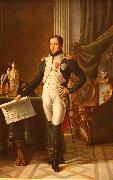 |
Jean Baptiste Wicar
|
|
Jean-Baptiste Wicar (22 January 1762, Lille - 27 February 1834, Rome) was a French Neoclassical painter and art collector.
The son of a carpenter, Wicar studied drawing at the free school in Lille before further honing his talents in the studio of David. The drawings Wicar created of Tableaux, statues, bas-reliefs et camees de la Galerie de Florence et du palais Pitti (Paintings, statues, bas-reliefs and cameos in the Gallery of Florence and the Pitti Palace) were published in Paris in 4 volumes at the Lacombe publishing house from 1789 to 1807.
Wicar headed the commission set up by Napoleon I of France to loot artworks from the Austrian Netherlands to enrich museums in France - an initial convoy left Antwerp on 11 August 1794, notably with paintings by Rubens, for the Louvre. Abbeys and castles were systematically emptied of their contents, furniture and works of art. Wicar was also a member of the commission des sciences et des arts on the Italian campaign, in the entourage of Bonaparte. This commission was charged with seizing artworks that could enrich French national museum collections. He finally permanently settled in Rome in 1800 and became a portraitist of European renown.
On his death in Rome, Wicar left the major collection of 1,300 drawings he had accumulated over his lifetime to the Societe des Sciences, de leAgriculture et des Arts de Lille. Mostly from the Italian school, but also in some small measure from the northern schools, it held drawings by artists like Raphael, Albrecht Derer, Lucas Cranach, Nicolas Poussin and Jacques-Louis David. |
|
|
|
|
|
|
|
|
|
|
|
|
|
|
|
|
|
|
|
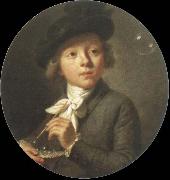 |
johann melchior wyrsch
|
|
johann melchior wyrsch (1732-98) was born in buochs, switzerland. in 1753 he went to rome to study with gaetano lapis and then at the academie francaise. |
|
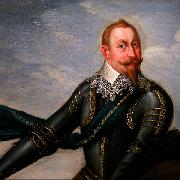 |
Johann Walter
|
|
painted Gustavus Adolphus of Sweden at the Battle of Breitenfeld in 1632 |
|
|
|
|
|
|
|
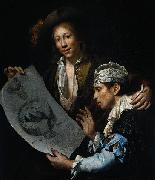 |
Johannes van Wijckersloot
|
|
Johan Hendriksz Van Wijckersloot (1557- 1602)
Born in Utrecht, Utrecht, Netherlands on 20 Oct 1557 to Hendrick Roelofsz Van Wijckersloot and Antonia Gosina Van Benthem. He passed away on 27 Jul 1602 in Utrecht, Utrecht, Netherlands |
|
|
|
|
|
|
|
|
|
|
|
|
|
|
|
|
|
|
|
|
|
|
|
|
|
|
|
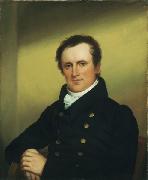 |
John Wesley Jarvis
|
|
(1781 - January 14, 1839), American painter, nephew of Methodist leader John Wesley, was born at South Shields, England, and was taken to the United States at the age of five.
He was one of the earliest American painters to give serious attention to the study of anatomy. He lived at first in Philadelphia, afterwards establishing himself in New York City, where he enjoyed great popularity, though his conviviality and eccentric mode of life affected his work. He visited Baltimore, Charleston, and New Orleans, entertaining much and painting portraits of prominent people, particularly in New Orleans, where General Andrew Jackson was one of his sitters. He had for assistants at different times both Thomas Sully and Henry Inman. He affected singularity in dress and manners, and his mots were the talk of the day. But his work deteriorated, and he died in great poverty in New York City. |
|
|
|
|
|
|
|
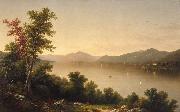 |
John William Casilear
|
|
(June 25, 1811 - August 17, 1893) was an American landscape artist belonging to the Hudson River School.
Casilear was born in New York City. His first professional training was under prominent New York engraver Peter Maverick in the 1820s, then with Asher Durand, himself an engraver at the time. Casilear and Durand became friends, and both worked as engravers in New York through the 1830s.
By the middle 1830s Durand had become interested in landscape painting through his friendship with Thomas Cole. Durand, in turn, drew Casilear's attention to painting. By 1840 Casilear's interest in art was sufficiently strong to accompany Durand, John Frederick Kensett, and artist Thomas P. Rossiter on a European trip during which they sketched scenes, visited art museums, and fostered their interest in painting.
Casilear gradually developed his talent in landscape art, painting in the style that was later to become known as the Hudson River School. By the middle 1850s he had entirely ceased his engraving career in favor of painting full-time. He was elected a full member of the National Academy of Design in 1851, having been an associate member since 1831, and exhibited his works there for over fifty years.
Casilear died in Saratoga Springs, New York in 1893. |
|
 |
John William Edy
|
|
John William Edy (1760 - 1820) was an English painter. He worked for the publisher John Boydell in London, often anonymously. In the summer of 1800 Edy visited Norway on an assignment for Boydell together with the landscape painter William Fearnside. They were in Norway from July 31 and until the end of September the same year.
|
|
|
|







